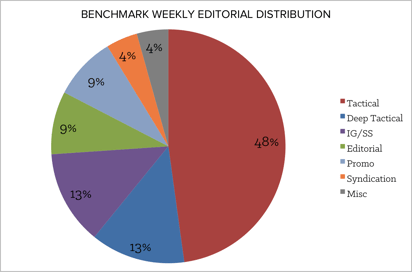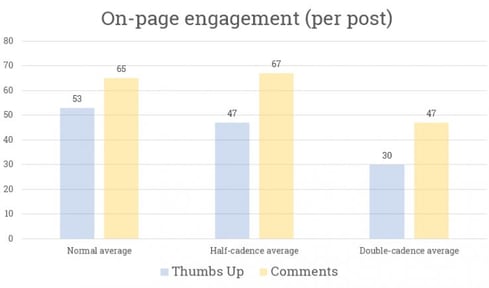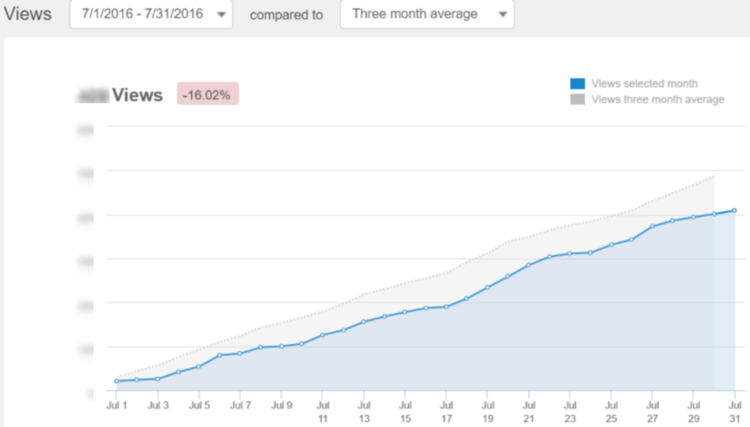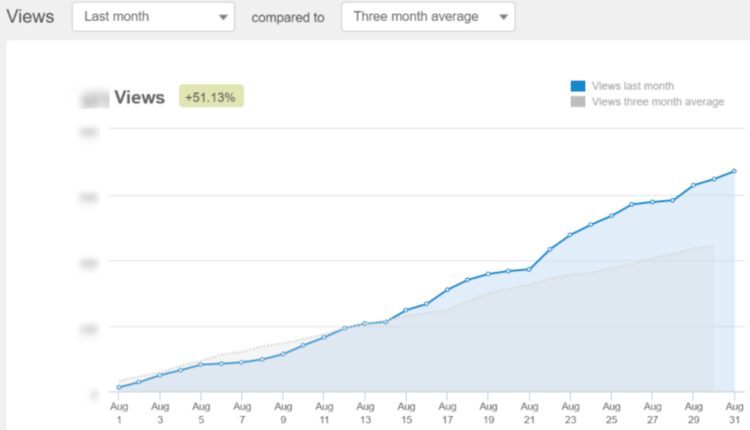We blogged everyday throughout the month of August in order to see what effect it had on traffic, leads and conversions. The results were more than impressive and you can see the growth here.

So, What Does Blogging Everyday Do For Your Business?
Opinion is divided as to whether blogging everyday is a good thing or not - a scan of the top Google results on the topic shows this - so we decided to try it out for a month and see what effect it had on our numbers.
It's a popular experiment that has been conducted by lots of big companies and sites, but isn't necessarily something every agency can do. Sometimes, your own work becomes secondary when you are working to produce content that brings results for your clients.
If you're big enough an agency, you could just take a writer off client work for a month and focus solely on your own site, if you don't do that already. But a company of our size doesn't work that way.
There's always the fear too that, in order to meet the increased frequency of posts, your content quality and/or length will inevitably drop. For our experiment, we maintained our typical post length - roughly 1,000 words - and aimed to keep the same amount of insight, research and value offered, i.e. the same level of quality.
Whether the posts are quality to read in terms of enjoyment is of course subjective, so isn't a factor. But hopefully you at least find our posts pleasant enough to read.
Okay, let's start getting into it.
What The Big Companies Found When They Conducted This Experiment

HubSpot's Findings
HubSpot took an in-depth approach which looked at comparing frequency and comprehensiveness of posts and the impact this had on views. For two weeks at a time, they posted different styles of posts from their usual 23 posts per working week. Their usual distribution of post styles are shown here:

Their two two-week-long variations and their findings are shown in this table:
| 2 Week Posting Style | Results |
| Low Volume, High Comprehensiveness (11.5 posts per workweek which are balanced towards more in-depth posts and less towards quick reads, infographics and slide shares) |
|
|
High Volume, Low Comprehensiveness (34.5 posts per workweek which are balanced more towards quicker reads and less towards their more in-depth posts) |
|
In terms of short term views and effects, posting with more frequency brought HubSpot more leads despite only a marginal increase in views.
If you've read the study, you'll know there was a lot of extra food for thought in terms of what makes up "comprehensiveness" of their posts but, in short, the higher frequency of posts didn't warrant the extra effort. Instead, they will be writing more of what brought in the leads at the benchmark frequency.

EXTRA READING: Buzzsumo's Comments
As a great piece of extra reading when it comes to the great content debate of Quality vs Quantity, this post by Buzzsumo is excellent. They have looked into the explosion of content being published everyday - for example, The Washington Post publishes around 1,200 posts a day - and aims to debunk the claim that "less is more" when it comes to content and that we have reached "peak content".
The author has also delved into the (scary for writers) practice of automated content, the success of high volume strategies and, amogst other things, the falling cost of content production and ease of producing it due to technology advances. And how this has lead to a rise in longtail targeting content.
The long and short of all this research is that Buzzsumo predict more and more companies will be publishing lots more content and prioritising quantity over depth and high-focus.

Moz's Findings
The Moz experiment focusses more closely on the effects of frequency than the HubSpot study which looks at post comprehensiveness too. Their variation to the benchmark routine was 4 weeks of half-frequency and double-frequency, respectively.
Unique views weren't impacted massively with a slight decrease for half-posting and slight increase for double-posting:

In terms of post engagement (thumbs up likes and comments on page), half-cadence maintained normal levels but posting twice as often saw reader engagement drop:

Meanwhile, they found there was no change on their email subscriptions signups (unlike HubSpot, who saw a number unsunscribers to blog update emails when posting more frequently - this is something worth noting if you are going to run this experiment yourself). They didn't get any negative feedback from their readership when they posted more or less often.
However - and this is very important in comparison to our own experiment - Moz largely use external writers, so posting more or less times per week didn't impact workload. Posting less didn't mean more time could be spent delving deeper into the topic, because the writers themselves weren't working under different parameters. It just meant the Moz editors could spend extra time suggesting edits (and work on other big projects).
But We are a Small B2B Agency, So How Would It Impact Us?
For context, we are a growing inbound marketing agency in North West England, who has recently been awarded Platinum Partner Agency status by HubSpot. But we aren't huge.
Therefore we don't employ loads of writers and have the ability to conduct an experiment like this and not see some impact on daily workload and output in other areas. So there's also a risk it would impact our business.
To undertake this experiment means changing our workload and how we plan our time day-to-day as it basically doubled the amount of blogs we (Steph and I, the two full time writers here at Digital 22) had to write for ourselves and there was always a risk something might have to give in terms of client work.
But in terms of results, in short, numbers are up. Let's take a look in depth.
The Starting Point
Prior to this experiment, we typically blogged twice a week in relation to our latest content download, plus any additional important news updates. This was serving us well, bringing in new business and leaving us with time to concentrate more heavily on work for clients.
As the business has grown and new members have joined the team, we've had the capacity to up our post count. Hence, we could experiment in blogging once a day, everyday, for a month.
Here's what the stats were like in July, the month before this experiment, in order to give a benchmark to measure against:
- We blogged 2-3 times per week.
- Website visits were consistent month to month.
This makes for a pretty good starting point for this experiment. Here are the screengrabs of graphs and finer details from within the HubSpot reporting tools:
General Blog Performance in July Compared To June

As you can see, we posted twice a week - plus one extra "news piece" - during July, which was four more blog posts than in June.
The low output during June was due to a combination of client work taking priority and spending our 'Digital 22 time' creating our next piece of downloadable content.
The key thing, however, is that more blog posts brought in more views. The August stats show that this continues when the scale is increased.
Blog Views In July Compared To Three Month Average

July's views were up on June's figures but a little down on the three month average. Looking into some more specifics, here's the best performing blog posts in terms of click-through-rate (CTR) and views.
July 2016's Most Click-Throughed Post Was From November 2015

It is worth noting that the top viewed post was a legacy post, from November 2015, not one which was put live during the month of July. Here it is, if you wish to check it out.
Whilst the number of blog views might not be shattering any records, the CTR and eventual customers arriving as a result of our work during July is very satisfactory.
Lead Generation During July

July's marketing report shows that visits to the site were in line with the three month average, contacts gained were just below what had come previous and we gained two new customers (a typical trend, month-on-month).
So, that's the data for July when we were blogging twice-a-week on average. Here is what happened when we blogged seven days a week for a month. 31 blogs in 31 days.
What We Blogged About During August
August saw us launch our latest content download, a 50+ page, free eBook titled How To Get MORE From YOUR Inbound Marketing, so this formed the central theme of our blog posts during the month.
As part of a normal campaign we would have usually blogged in relation to the content of the eBook twice per week. But during this experiment we upped that to three or four times.
The other three to four posts per week (depending on the number of campaign blogs) were general industry-related posts and news updates. Things like updates about what Google had changed in the past 24 hours - they were very busy making changes and testing lots of new features during August. This helped with offering alternative content in our posts and offered a break from pushing ideas related to the eBook.
How Often Should I Blog? Here's The Results Of Blogging Everyday For A Month
Here we go, a blog everyday resulted in these kinds of numbers:
- +325 more views in August compared to the previous month's views.
- Views increased by over 51% compared to the three month average.
- Website views increased by over 36%.
- Twice as many contacts were gained compared to July.
- We gained twice as many customers too.
22 More Posts Resulted In Almost 200% More Views

Whereas July saw four extra posts compared to June and brought 18% more views, August saw 22 more posts and a whopping 195% more views month-on-month.
This shows that the more you post, the effect on views appears to compounded. The more you up your proficiency, the more your views increase.
+51% More Blog Views In August Compared To Three Month Average

The first half of the month saw views follow the three month average pretty closely. However, following the 15th of the month, views kept climbing well above what had come in the three months previous.
The end result was +51% views against the three month average.
The Most Viewed Posts Were Posted That Month

During August, the top viewed post went live that same month, as opposed to being a legacy post that we rank well for, like in July. The usual monthly top viewed post is in third place. This shows our newer blogs were attracting lots more new traffic shortly after they had been published.
More Contacts And Customers When We Blogged Everyday

Okay, the meaty stuff. And it's good news. Blogging once a day in August resulted in better numbers in terms of our marketing performance.
We got close to plenty more website visits, nearly twice as many contacts as usual and converted twice as many customers.
How Blogging Everyday Impacted Workload
Producing and sharing 7 blog posts a week does need to be a team effort. We don't work 7 days a week and have client work to complete too.
If you are writing blogs that are part of your content campaign, a new technique or advising on how to do something which is related to content available in your latest eBook, the research for your blog has already taken place. This speeds up the process of writing campaign blog posts and is defnitely handy when you have a client deadline.
News pieces are also a quick win, in terms of writing, but then they do need the typical amount of fresh research. This research process is also lengthened when you factor in trawling through various outlets to find something newsworthy.
Blogs which aren't already researched as part of your campaign obviously take up the most amount of time.This means you need to balance how much time is spent on researching new blog content otherwise something is going to have to give - the quality of your posts or time spent completing client work. And you don't want to impact either of those.
Generally though, a little extra work never hurt anybody. If you have a team of two full-time writers (like us), a blog a day for your company in addition to client work is completely achievable.

Advice On Blogging Everyday For Smaller Companies
We made sure that the first thing we did every morning was concentrate on our own blog.
To facilitate this, we advise spending a bit of time at the beginning of the month getting ahead of the game and queueing up posts.
This means that if any extra client work crops up (which it did during our experiment), you have a bit of slack in your own blog-a-day schedule.
We had some extra demands from a client and internal holidays (both writers ended up out of the office at the same time) in the middle of the month. This meant that the queue of posts quickly got exhausted. But an extra couple of hours work soon rectified that little issue.
Another piece of advice, based on our experience; don't forget that weekend takes two blogs posts out of your queue, in additition to Friday and Monday. It feels like you are losing a lot out of your queue in a short space of time, so aim to front load your blog-a-day time to the beginning of the week. This will make sure you have some slack Wednesday-Friday for additional client work.
Hopefully this has helped to answer your question, "Should I blog everyday", especially if you're a small business, like us. It needs to be considered as part of a wider strategy and you should follow these simple tips if you want to blog everyday:
- Don't scrimp on quality.
- Be more concise in your word count.
- You will likely have to include some industry and company news.
- Always keep a run of posts done and scheduled.
- You will need to make extra time for managing social media too.
- Make sure your site is optimised for the increased traffic (correct CTAs, email automation is ready to go).
What Happens Now
In the interest of experimentation (and to fulfill the demands of a couple more clients coming live this month), we will scale back this project to blogging every weekday for the month of September.
We are aiming to find out if seven posts a week resulted in nearly 200% more views (compared to July, which had the old tactic of two posts per week), what will the effect be if we post five times a week?
This is noticeably less work, but will it noticeably impact results?
We will let you know in October.
If This Has Been Of Interest...
We have a whole eBook full of useful tips and techniques to help you get more from your marketing. And it's free.
Do you want to get more from your inbound marketing results, just like we did this month? Then Get The Guide right now...
Real Growth. Real Impact.
'Should I use HubSpot?' 32 fundamental reasons why you should
21 cost-effective marketing campaigns you can create right now
Breeze: Everything you need to know about HubSpot's powerful AI
INBOUND 24 learnings and updates
Google Search API leaks: All you need to know [LIVE BLOG]
The top 6 marketing challenges of 2024
Inbound vs outbound marketing: What's the difference?
See why enterprises choose Avidly
Let’s build your HubSpot success story
Compelling final call to action - with accompanying link to Contact page





![Google Search API leaks: All you need to know [LIVE BLOG]](https://www.avidlyagency.com/hs-fs/hubfs/cloud.jpg?width=400&height=225&name=cloud.jpg)


